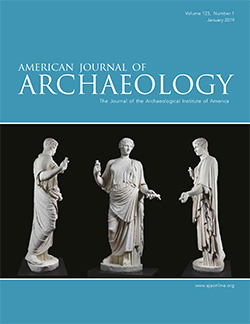AJA Open Access
BY-NCJanuary 2019 (123.1)
Book Review
Patina: A Profane Archaeology
By Shannon Lee Dawdy
Reviewed by William Caraher
The contemporary urban landscape of New Orleans might not seem professionally relevant to archaeologists of the ancient Mediterranean, but Dawdy’s nuanced survey of patina in the city both before and after the Katrina in 2005, offers a compelling offers a compelling consideration of the intersection of archaeology and modernity. For Dawdy, patina is more than simply the mud left behind on buildings in the aftermath of the hurricane; it is a part of the past-in-the-present that saturates the historical fabric of the city itself. An emphasis on patina offers a particularly important critique of linear time that supports disciplinary periodization as well as narratives of progress and commodity capitalism that shape our modern world.
For Dawdy, New Orleans offered a series of carefully constructed case studies for how patina developed. Dawdy starts with the distinctive appearance of the “Katrina Patina,” the marks of the hurricane left by mud and recovery teams on so many of the buildings in the city. Drawing on her long experience of archaeological fieldwork in the city, she demonstrates how the patinated past pushes through into present-day New Orleans. This creates a framework for a discussion of heterogeneous time in the diverse assemblage of artifacts found in her excavation of the gardens around St. Louis Cathedral and in the remains of the Duplessis plantation house beneath the Maginnis Cotton Mill building. The intermingling of the past in the present likewise emerges in New Orleans’ famous ghost stories that have provided an opportunity for “haunted tour” operators and played a central role in the city’s reputation for the macabre. Dawdy’s excavations at the Rising Sun Hotel site naturally attracted national attention, but the interplay between the subsiding ruins of the collapsed and charred hotel and later structures on the site provided a literal example of the past shaping the present. The interplay between objects, agency, and memory likewise manifests itself in the historical interest in antiques and the diverse rituals of the New Orleans streetscape. The famous parades of Mardi Gras, for example, bring together neighborhoods through the use of nostalgia, tradition, and history. Whatever figurative or symbolic weight Dawdy ascribes to patina in New Orleans, it remains a literal feature of the city, its neighborhoods, and its objects. As a result, this book is not an abstract theoretical meditation but one that is grounded in archival research, archaeological field work, and interviews and conversation with a range of residents and that produced perspective on the patina that permeates people’s homes, businesses, and everyday lives.
Dawdy’s interest in patina as the interplay of objects, narratives, memories, and time also applies to the archaeological and cultural theories on which she draws throughout her book. Dawdy imparts new life to the perspectives of Benjamin, Freud, and Durkheim in the service of a critical nostalgia. Benjamin’s well-worn arcades project offers a point of departure for a sustained critique of modern capitalism and consumerism, with the book’s subtitle “A Profane Archaeology” alluding to Benjamin’s concept of “profane illumination.” For Benjamin, the profane illumination represented a radical view of the world infused with hashish smoke and surrealism (9). Freud’s concept of the fetish complemented Benjamin’s celebration of the irrational by adding a religious dimension to the material world that resonated with the orientalized sexuality of New Orleans. Freud produced a useful complication to Marx’s influential concept of commodity fetishism by emphasizing the deeply personal character of the fetish as a manifestation of its irreducible materiality shaped by contingency of events and social relations. The spiritual aura surrounding the fetishized object evokes Durkheim’s concept of mana, which offers a foil to understand how patina complicates the tidy rationality of the modern world. There is something ineffable in the way objects acquire and communicate patina that makes the contingency of both the object and time itself much clearer. The materiality of patina and its irrational significance offer a view of the past that resists the rather more linear and orderly perspective offered by the “invention of traditions” (E.J. Hobsbawm and T.O. Ranger, The Invention of Tradition [Cambridge 1983]) and embodies the dynamic and recursive time of embodied in patina. Dawdy cleverly employs modernist thinkers like Benjamin, Freud, and Durkheim to offer unironic commentaries on the unpredictable relationship of the past to the present.
The conclusion of the book presents Dawdy’s elaborate argument in its essence. In New Orleans, patina presents a real, physical critique of commodification and commercialism, progress and modernity, and the linearity of time. It also bonds the past to the present and individuals to objects. By doing so, patina conjures heterotopic spaces throughout the city. These are, following Foucault’s concept of heterotopia, realized expressions of utopian fantasies. Like the Paris arcades, mana, and the fetish, heterotopias are both real and set apart from a banal world infused with a kind of chronotopic time that passes in rhythms distinct from everyday life (148). Dawdy tends to see such places and times as finding particular expression in certain cities—New Orleans, San Francisco, Istanbul—where deeply ingrained practices and places push back against the relentless tide of progress and commodity capitalism, but this perhaps constrains her argument unnecessarily. The accelerated pace of change in the contemporary world has subjected such ordinary objects as Atari games, long-playing records, and even the profound banality of the abandoned modern office to similar critical nostalgia that infuses even rapidly accumulating signs of wear with patina and questions the seemingly inevitable horizon of obsolescence associated with commodity capitalism. In short, patina might be more prevalent and visible in places like New Orleans, but the critique that it implies has a much wider significance.
William R. Caraher
Department of History
University of North Dakota
william.caraher@und.edu
